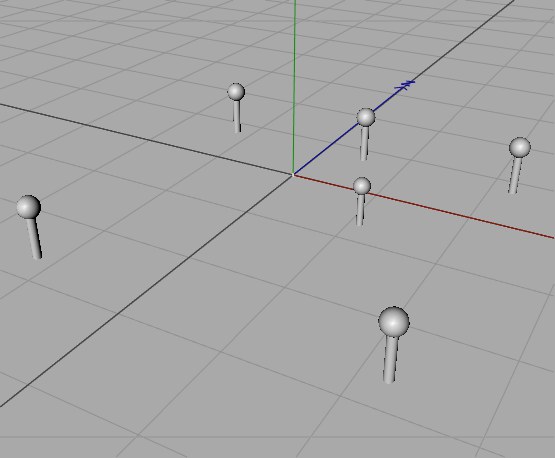Microphone
This function creates a group of objects that contains two conventional, spatially shifted mono microphones.
- Microphone_L (for the left stereo channel).
- Microphone_R (for the right stereo channel).
You can make individual adjustments to the characteristics of both microphones (see Mono Microphone)

The DTS 5.1 (Digital Theatre System) function creates automatically a group of objects which contains six conventional, spatially-shifted mono microphones.
- Microphone_L (for the left front loudspeaker).
- Microphone_C (for the central loudspeaker).
- Microphone_R (for the right front loudspeaker).
- Microphone_SUB (for the bass channel, sub-woofer).
- Microphone_LS (for the left, rear surround loudspeaker).
- Microphone_RS (for the right, rear surround loudspeaker).

The WAV files created with subsequent 3D sound rendering can be mixed later in an external sound program for the generation of surround sound data in the DTS 5.1 format. You can define individual values for the pickup characteristic etc. of all microphones (see Mono Microphone).
The DDS EX 6.1 (Dolby Digital Surround) function creates, automatically, a group of objects which contains seven conventional, spatially-shifted mono microphones.
- Microphone_L (for the left front loudspeaker).
- Microphone_C (for the central loudspeaker).
- Microphone_R (for the right front loudspeaker).
- Microphone_SUB (for the bass channel, sub-woofer).
- Microphone_LS (for the left, rear surround loudspeaker).
- Microphone_S (for the middle, rear surround loudspeaker).
- Microphone_RS (for the right, rear surround loudspeaker).

The WAV files created with subsequent 3D sound rendering can be mixed later in an external sound program for the generation of surround sound data in the DDS EX 6.1 format. You can define individual values for the pickup characteristic etc. of all microphones (see Mono Microphone).
The SDDS 7.1 (Sony Dynamic Digital Sound) command creates a group of objects which contains eight conventional, spatially-shifted mono microphones.
- Microphone_L (for the left front loudspeaker).
- Microphone_L (for the left center loudspeaker).
- Microphone_C (for the middle center loudspeaker).
- Microphone_R (for the right center loudspeaker).
- Microphone_R (for the right front loudspeaker).
- Microphone_SUB (for the bass channel, sub-woofer).
- Microphone_LS (for the left, rear surround loudspeaker).
- Microphone_RS (for the right, rear surround loudspeaker).

The WAV files created with subsequent 3D sound rendering can be mixed later in an external sound program for the generation of surround sound data in the SDDS 7.1 format. You can define individual values for the pickup characteristic etc. of all microphones (see Mono Microphone).